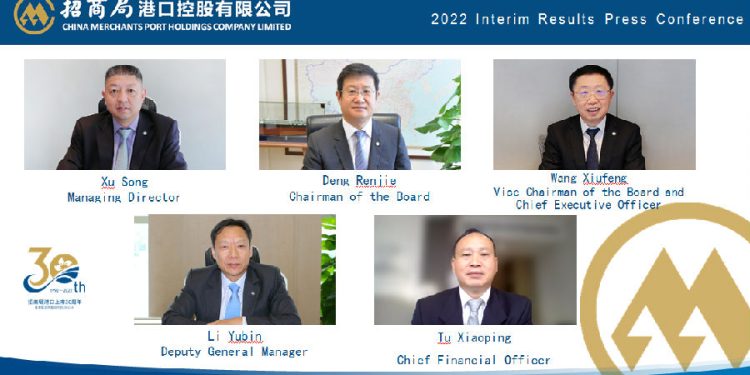CMPort’s group revenue for first half of 2022 was up 15% year-on-year to HK$6.5bn (US$830m), with the increase mainly attributed to a growth in both business volume and tariff of ports operation.
Recurrent profit increased 10% to HK$5bn (US$630m) due to the combined effect of an increase in revenue and an increase in share of profits of associates of the group.
Deng Renjie, chairman of the CMPort board, said: “It is expected that the business of the company will maintain steady for the full year.
“Driven by the expected increase in throughput volume and tariff, the group’s terminals will generate more profit; coupled with cost control, the company’s recurrent profit is expected to grow steadily in 2022.”
Throughput at the group’s ports dropped by 0.3% year-on-year to 66.3m teu with the group’s ports in Mainland China, Hong Kong and Taiwan contributed an aggregate container throughput of 49.4m teu – down 1%.
The main reason for the slight decrease in volumes was the ongoing impact of the recurring pandemic during the first half of 2022.
CMPort’s overseas facilities handled a total container throughput of 16.9m teu, up 1.5% year-on-year, mainly thanks to Terminal Link and the growth in throughput volume of controlled overseas terminals of the group.
The group’s bulk cargo volume decreased 5% year-on-year to 269m tonnes, among which the group’s mainland China ports handled 266m tonnes also representing a decrease of 5% year-on-year.
The decline was mainly attributed to the impact of the unstable pandemic situation in various regions.
CMPort’s CAPEX in the first half of 2022 was HK$3.5bn (US$450m) mainly for the acquisition of additional shareholding in Asia Airfreight Terminal Company Limited (AAT) and Shanghai International Port Group Co. Ltd (SIPG) with a total of HK$2.6bn (US$330m).
Fixed asset expenditure was about HK$740m (US$90m) largely used for various projects such as the Mawan Smart Port, Ningbo Daxi, LCT and Shantou Port.
Tu Xiaoping, CFO of CMPort, said: “As of June 30, 2022, the company has nearly HK$9bn (US$1.1bn) in cash and bank deposits; coupled with the continuous stable operating cash flow generated from the port business in the second half of the year, the company has sufficient funds to cover future capital expenditures and pay dividends.”
In the first half of 2022, the operator adhered to its strategic objective of “building world-class leading ports” to further improve the comprehensive competitiveness of its West Shenzhen homebase port as a world-class port.
The Chinese company officially launched the Global Fruit & Vegetables Inbound Digital Trade Centre in this period, designed to offer efficient, convenient and standardised platform services throughout the whole process of online transactions for fruit and vegetable customers at the port.
CM Port’s Mawan Smart Port in West Shenzhen, which opened in 2021, has received 3,710 vessels and achieved 1m teu container throughput with 28 new shipping routes in its first year of operation.
Furthermore, the group set up 20 coordinated ports in the Great Bay Area to smooth and stabilise operations.
The Coordinated Ports Model increased logistics efficiency and reduced transportation costs, according to the operator, reducing the time required for water-to-water transhipment of import and export containers by 60% to two days.
During the Shenzhen outbreak in March, CMPort’s West Shenzhen port responded with scientific and targeted measures and was able to restore its operational capacity rapidly, recording a 3% growth in container throughput in the first half of 2022.
Additionally, CMPort successfully launched its Container Terminal Operating System (CTOS) at the Thessaloniki Port in Greece, which covered more than 60 operating procedures and over 20 transaction types at the port.
A pilot programme of ‘CM ePort’ has been launched at the West Shenzhen port to explore new service models for cargo owners by the online platform of container truck assistant service.
Looking ahead to the second half of the year, it is expected that uncertainties in the global economy and trade will remain, according to the Hong Kong-based firm.






